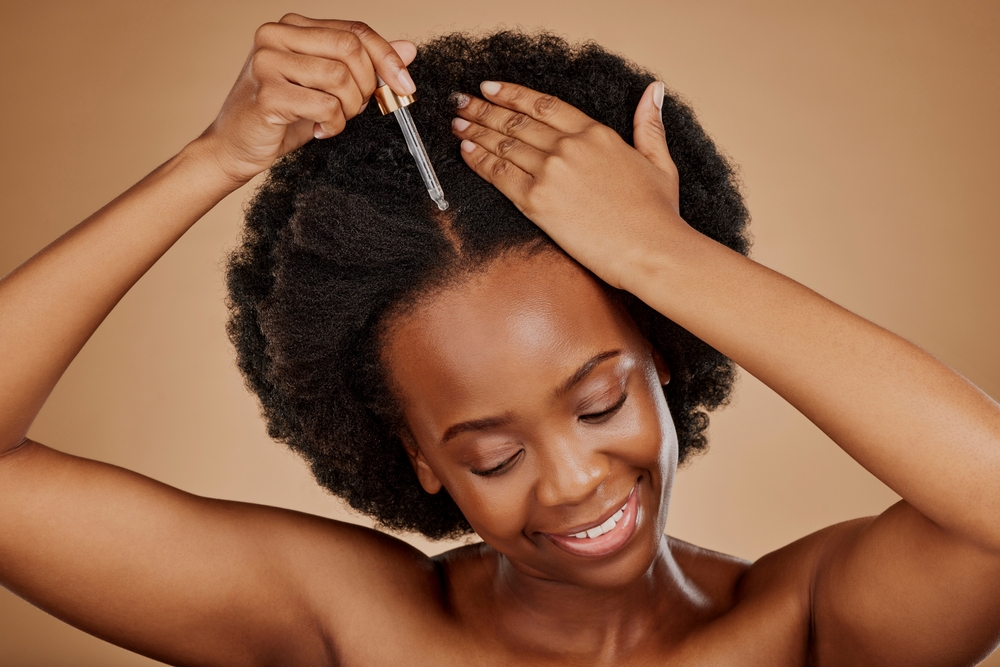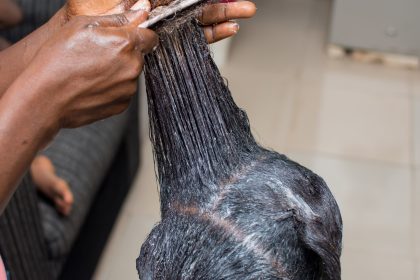The pursuit of longer, thicker hair frustrates many people struggling with slow growth, thinning, or excessive shedding. While the average scalp hair grows approximately half an inch monthly, optimizing your nighttime routine can dramatically enhance this rate by addressing the biological factors that influence hair growth cycles. Understanding how hair grows—and what impedes its progress—reveals why specific nighttime practices can transform your hair’s thickness, length, and overall health.
Understanding the science of hair growth
Hair growth follows a complex biological cycle that determines how quickly and healthily your strands develop. Optimizing this cycle creates the foundation for accelerated growth.
Each hair follicle operates independently, cycling through three distinct phases. The anagen (growth) phase typically lasts 2-7 years and determines your maximum potential hair length. The catagen (transition) phase lasts approximately two weeks, during which growth stops and the follicle shrinks. The telogen (resting) phase spans 3-4 months before the hair sheds naturally, making room for new growth.
Several factors regulate these growth phases, many of which can be influenced by nighttime routines. Blood circulation delivers oxygen and nutrients to follicles, with better circulation supporting longer anagen phases and healthier growth. Hormone balance significantly impacts hair growth, with dihydrotestosterone (DHT) often causing follicle miniaturization when present in excess. Inflammation at the follicle level disrupts normal growth cycles, potentially pushing hair prematurely from anagen to telogen phase.
The nighttime represents an ideal opportunity to influence these factors. During sleep, your body engages in cellular repair and regeneration, with growth hormone levels peaking approximately an hour after falling asleep. This hormone directly stimulates cell production in hair follicles, making sleep quality crucial for hair growth. Additionally, the extended, uninterrupted application of treatments overnight maximizes their effectiveness compared to daytime use when products may be quickly removed or diluted.
Understanding these biological realities reveals why a comprehensive nighttime routine—addressing circulation, nutrition, protection, and growth stimulation—can potentially double your hair growth rate by extending the anagen phase, improving follicle health, and optimizing the growth environment.
Evening scalp massage with essential oils
A properly executed scalp massage with growth-promoting oils forms the cornerstone of any effective hair growth routine, stimulating circulation while delivering active compounds directly to follicles.
Begin with dry hair, sectioning it to ensure full scalp access. Using your fingertips (not nails), apply medium pressure in small, circular motions across your entire scalp for 5-10 minutes. This mechanical stimulation dramatically increases blood flow to follicles, delivering oxygen and nutrients while removing waste products that may impede growth.
The massage becomes significantly more effective when paired with specific carrier and essential oils. Jojoba oil closely resembles human sebum, allowing it to balance oil production without clogging follicles. Castor oil, particularly Jamaican black castor oil, contains ricinoleic acid that improves circulation and reduces inflammation. Coconut oil penetrates the hair shaft to prevent protein loss while providing antimicrobial benefits that support a healthy scalp environment.
Essential oils deliver concentrated active compounds that address specific growth challenges. Rosemary oil has demonstrated comparable results to minoxidil in clinical evaluation, improving circulation while blocking DHT that contributes to hair thinning. Peppermint oil creates a cooling sensation while significantly increasing circulation and extending the anagen growth phase. Lavender oil combines anti-inflammatory properties with stress-reducing aromatherapy benefits, addressing multiple growth obstacles simultaneously.
Create an effective blend by combining one tablespoon of your chosen carrier oil with 2-3 drops each of 2-3 essential oils, adjusting proportions based on scalp sensitivity. Apply this mixture with your fingertips during the massage, focusing on areas of thinning or concern while ensuring complete coverage.
After massaging thoroughly, wrap your hair in a warm towel for 20-30 minutes to enhance oil penetration through gentle heat. This step significantly improves the delivery of active compounds to the follicle level where they can influence growth cycles most effectively.
Individuals with particularly oily scalps may prefer performing this treatment 2-3 times weekly rather than nightly, while those with dry scalps often benefit from nightly application. Regardless of frequency, consistency delivers the most dramatic improvements in growth rate and thickness.
Nighttime nutrition for optimal hair growth
Internal nutrition plays an equally important role in accelerating hair growth, with evening consumption of specific nutrients strategically supporting overnight follicle development.
Protein provides the building blocks for new hair growth, as hair consists of approximately 95% keratin protein. Evening consumption of 15-25 grams of complete protein supplies essential amino acids during the night when repair and growth processes intensify. Collagen peptides specifically provide glycine, proline, and hydroxyproline—amino acids concentrated in hair structure—making them particularly beneficial for growth.
Biotin (vitamin B7) serves as a critical cofactor for keratin production, with deficiencies directly linked to hair thinning and breakage. While topical application shows limited benefits due to the vitamin’s molecular size, internal consumption ensures it reaches follicles through the bloodstream. Evening supplementation or consumption of biotin-rich foods like eggs, almonds, or sweet potatoes supports overnight hair synthesis.
Zinc plays essential roles in protein synthesis, cell division, and tissue growth—all crucial for hair development. This mineral also helps regulate hormone levels that influence hair growth cycles, including testosterone metabolism. Foods rich in zinc include oysters, pumpkin seeds, and beef, with evening consumption supporting the body’s natural nighttime repair processes.
Iron carries oxygen to follicles, with deficiencies representing a leading cause of hair loss, particularly in menstruating women. Pairing iron-rich foods like spinach, lentils, or grass-fed beef with vitamin C enhances absorption. Evening consumption ensures optimal levels during night-time growth phases.
Vitamin D influences follicle cycling, with research linking deficiencies to various forms of hair loss. Since natural production requires sunlight, evening supplementation or consumption of vitamin D-rich foods like fatty fish helps maintain adequate levels, especially during winter months or for those with limited sun exposure.
Evening tea rituals can further support hair growth through specialized herbal formulations. Nettle tea helps block DHT and provides silica that strengthens hair structure. Horsetail tea offers additional silica while supporting collagen production important for follicle health. Bamboo tea contains the highest natural concentration of silica (70%) of any plant, directly supporting stronger, faster-growing hair.
For optimal results, consume these nutrients 1-2 hours before bedtime, allowing initial digestion to complete before sleep while ensuring nutrients remain available throughout the night when growth hormone levels peak.
Protective styling and overnight moisture treatments
Preventing mechanical damage and moisture loss during sleep creates an environment where hair growth can progress unimpeded, transforming your length retention dramatically.
Cotton pillowcases create friction that damages hair cuticles and absorbs natural oils needed for healthy growth. Switching to silk or satin pillowcases significantly reduces this friction, preserving both hair structure and moisture. The smooth surface allows hair to glide without catching or tangling, preventing the breakage that makes growth progress seem non-existent despite continued production from follicles.
Protective hairstyles prevent the constant movement and tangling that lead to mechanical damage during sleep. Loose braids distribute tension evenly while minimizing friction points. The pineapple method—gathering hair loosely at the crown with a silk scrunchie—works particularly well for curly textures. A loose, high bun secured with non-damaging pins or sticks protects ends while preventing tension at the roots that could impede circulation.
Overnight moisture treatments address hydration at a deeper level than daytime conditioning. Hair mask formulations containing glycerin, aloe vera, and panthenol draw moisture into the hair shaft and seal it there, preventing the dehydration that leads to brittleness and breakage. Specialized bond-building treatments containing proteins and amino acids repair structural damage within the hair shaft, strengthening existing growth and improving resilience against future damage.
For those seeking enhanced benefits, silk or satin lined caps worn over treatment-coated hair create a microclimate that boosts product penetration while simultaneously protecting against friction. This approach proves particularly beneficial for those with high porosity hair that typically struggles to retain moisture.
The right approach varies based on hair texture and concerns. Fine, straight hair typically benefits from loose buns with lightweight hydrating mists to prevent flattening. Thick, curly hair often requires more substantive creams or butters and protective styles that preserve curl pattern. Coily or kinky hair generally needs the richest emollients and most protective styling to retain length and moisture.
Growth-stimulating scalp treatments
Specialized topical treatments applied before sleep directly influence the follicle environment, potentially doubling growth rates by extending the anagen phase and improving follicle function.
Peptide treatments deliver amino acid chains that serve as cellular messengers, signaling follicles to enter and maintain the growth phase. Copper peptides specifically support blood vessel formation around follicles while regulating inflammation that might otherwise impede growth. These lightweight formulations absorb quickly without creating greasiness, making them ideal for nightly use even for those with fine hair.
Caffeine solutions applied topically penetrate to the follicle level within 2-8 minutes, where they block DHT while stimulating cell energy production. This dual-action approach proves particularly effective when applied at night, as the caffeine remains active at the follicle level for 24+ hours without washing away. The stimulating properties specifically counteract testosterone/DHT effects that contribute to pattern thinning in both men and women.
Growth factor serums contain specialized proteins that regulate cell division and development. While naturally present in the body, topical application concentrates these compounds where needed most. Products containing multiple growth factors address different aspects of follicle function simultaneously, supporting the complex cellular environment necessary for optimal growth.
Microneeding tools create microscopic channels in the scalp that enhance absorption of growth treatments while stimulating the body’s wound healing response. This controlled injury triggers growth factors, increases blood flow, and activates stem cells in the follicle. For home use, devices with needles between 0.25-0.5mm provide benefits without risk, though treatments should be limited to weekly application followed by sterile growth serums.
Specialized night caps infused with copper or silver particles create an antimicrobial environment that reduces growth-inhibiting bacteria and fungi on the scalp. These innovative textiles simultaneously reduce friction while creating optimal conditions for follicle health throughout the night.
For those dealing with significant thinning, prescription treatments like minoxidil (available over-the-counter) show enhanced efficacy when applied at night due to increased absorption during sleep and decreased removal through daily activities. The 8+ hours of continuous contact significantly improves results compared to daytime-only application.
Stress reduction and sleep optimization
The quality and quantity of sleep directly impacts hair growth through hormonal regulation, making evening relaxation practices crucial for accelerated results.
Cortisol, the primary stress hormone, directly inhibits hair growth when chronically elevated. High cortisol levels push follicles prematurely into the catagen and telogen phases, reducing the time spent actively growing. Evening stress reduction techniques create hormonal conditions that support extended anagen phases.
Implement a digital sunset by eliminating blue light exposure from phones, computers, and televisions for 1-2 hours before bed. Blue light suppresses melatonin production, disrupting sleep cycles and potentially affecting growth hormone release that supports overnight hair development. Use this time instead for relaxation practices that lower cortisol.
Breathing techniques, particularly the 4-7-8 method (inhale for 4 counts, hold for 7, exhale for 8), activate the parasympathetic nervous system, reducing stress hormones while improving sleep quality. Practicing this technique for 5 minutes before bed creates optimal hormonal conditions for hair growth during sleep.
Adaptogens—herbs that help the body resist stressors—show particular benefits for stress-related hair issues. Evening consumption of ashwagandha has demonstrated effectiveness in reducing cortisol levels, while holy basil (tulsi) improves stress resilience. Both create internal conditions more favorable for maintaining the anagen growth phase.
Meditation focused specifically on scalp awareness combines stress reduction with increased blood flow to follicles. This practice involves progressively tensing and releasing the scalp muscles while visualizing increased circulation. Even 5-10 minutes nightly demonstrates measurable improvements in both sleep quality and follicle health.
Temperature regulation significantly impacts sleep quality and subsequent hair growth. Setting bedroom temperature between 65-68°F (18-20°C) supports the natural drop in core temperature that triggers deep sleep, during which growth hormone secretion peaks. This optimal temperature simultaneously creates conditions where scalp treatments remain active without excessive perspiration diluting their effectiveness.
Hydration and evening supplements
Strategic evening hydration complements topical treatments by supporting blood flow and nutrient delivery to follicles during sleep.
Proper hydration thins the blood slightly, allowing it to travel more easily through the small capillaries feeding hair follicles. This improved circulation delivers oxygen and nutrients more efficiently while removing cellular waste products that might otherwise impede growth. Aim for 8-16 ounces of water 1-2 hours before bed, allowing time for processing before sleep to prevent disruptions from nighttime bathroom visits.
Certain herbal infusions enhance hydration benefits when consumed in the evening. Bamboo leaf tea provides silica that strengthens hair structure from within while supporting circulation. Nettle tea helps regulate DHT levels that might otherwise shorten the anagen growth phase. Horsetail tea offers additional silica along with selenium and cysteine that support keratin formation during sleep.
Evening supplement timing significantly impacts their effectiveness for hair growth. Collagen peptides taken 30-60 minutes before bed provide amino acids necessary for overnight hair synthesis, with studies showing improved thickness with consistent use. Magnesium supplements support sleep quality while regulating hormones that influence hair growth cycles. Vitamin D, when taken in the evening, helps regulate the genes involved in hair cycling.
Specialized hair growth supplements containing combinations of biotin, zinc, iron, vitamins A and D, and amino acids often prove most effective when taken with evening meals. This timing allows fat-soluble components to be absorbed properly while ensuring nutrients remain available during peak nighttime growth periods.
For those struggling with inflammation-related hair issues, evening consumption of omega-3 fatty acids helps regulate inflammatory processes that might otherwise impede growth. Sources like fish oil or algae oil supplements taken with dinner support the body’s natural anti-inflammatory processes during sleep.
Tracking progress and adjusting your routine
Documenting results and making strategic adjustments maximizes the effectiveness of your nighttime hair growth routine.
Establish baseline measurements before beginning your routine, including hair density, diameter, growth rate, and overall length. Standardized photography from multiple angles with consistent lighting provides visual reference, while measuring growth from a designated point (such as distance from ear to ends) offers numerical tracking.
The anagen growth phase spans months, making patience and consistency essential. Commit to following your chosen routine for at least 3-4 months before expecting visible results. New hairs typically take this long to emerge and grow long enough to create noticeable changes in overall appearance.
Keep a simple journal noting routine adjustments, product changes, and any factors that might influence results. This documentation helps identify which elements deliver the greatest benefits for your specific hair type and concerns, allowing for personalized optimization.
Certain growth phases occur seasonally, with research indicating faster growth during late spring and summer. Adjust expectations accordingly, and consider intensifying treatments during seasonal slow periods to maximize year-round results.
Hair growth responds to internal hormonal fluctuations, particularly for women experiencing menstrual cycles, pregnancy, or menopause. Track these patterns alongside your growth documentation to identify correlations that might inform timing adjustments for treatments.
If your chosen routine includes multiple elements, consider implementing them sequentially rather than simultaneously. This approach allows you to identify which specific practices deliver the most significant benefits for your hair type, enabling a more targeted and efficient routine over time.
When properly implemented, this comprehensive nighttime routine addresses every biological factor influencing hair growth—from circulation and nutrition to protection and hormonal balance. The results typically begin with improved thickness and decreased shedding within 4-6 weeks, followed by accelerated length within 3-4 months as the percentage of hairs in the active growth phase increases substantially.
While individual results vary based on genetics, hair type, and underlying health conditions, most people following this evidence-based approach experience growth rates 50-100% above their baseline, transforming both their hair’s appearance and their confidence through strategic nighttime practices that work with the body’s natural growth cycles.











